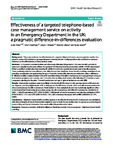Effectiveness of a targeted telephone-based case management service on activity in an Emergency Department in the UK: a pragmatic difference-in-differences evaluation
| dc.contributor.author | Elston, Julian | |
| dc.contributor.author | Gradinger, Felix | |
| dc.contributor.author | Streeter, Adam | |
| dc.contributor.author | Macey, S | |
| dc.contributor.author | Martin, S | |
| dc.date.accessioned | 2022-08-25T11:15:10Z | |
| dc.date.issued | 2022-08-15 | |
| dc.identifier.issn | 1472-6963 | |
| dc.identifier.issn | 1472-6963 | |
| dc.identifier.other | 1038 | |
| dc.identifier.uri | http://hdl.handle.net/10026.1/19574 | |
| dc.description.abstract |
<jats:title>Abstract</jats:title><jats:sec> <jats:title>Background </jats:title> <jats:p>This study evaluates the effectiveness of a targeted telephone-based case management service that aimed to reduce ED attendance amongst frequent attenders, known to disproportionately contribute to demand. Evidence on the effectiveness of these services varies.</jats:p> </jats:sec><jats:sec> <jats:title>Methods</jats:title> <jats:p>A 24-month controlled before-and-after study, following 808 patients (128 cases and 680 controls (41 were non-compliant)) who were offered the service in the first four months of operation within a UK ED department. Patients stratified as high-risk of reattending ED within 6 months by a predictive model were manually screened. Those positively reviewed were offered a non-clinical, nurse-led, telephone-based health coaching, consisting of care planning, coordination and goal setting for up to 9 months. Service effectiveness was estimated using a difference-in-differences (DiD) analysis. Incident rate of ED and Minor Injury Unit (MIU) attendances and average length of stay in intervention recipients and controls over 12 months after receiving their service offer following ED attendance were compared, adjusting for the prior 12-month period, sex and age, to give an incidence rate ratio (IRR).</jats:p> </jats:sec><jats:sec> <jats:title>Results</jats:title> <jats:p>Intervention recipients were more likely to be female (63.3% versus 55.4%), younger (mean of 69 years versus 76 years), and have higher levels of ED activity (except for MIU) than controls. Mean rates fell between periods for all outcomes (except for MIU attendance). The Intention-to-Treat analysis indicated non-statistically significant effect of the intervention in reducing all outcomes, except for MIU attendances, with IRRs: ED attendances, 0.856 (95% CI: 0.631, 1.160); ED admissions, 0.871 (95% CI: 0.628, 1.208); length of stay for emergency and elective admissions: 0.844 (95% CI: 0.619, 1.151) and 0.781 (95% CI: 0.420, 1.454). MIU attendance increased with an IRR: 2.638 (95% CI: 1.041, 6.680).</jats:p> </jats:sec><jats:sec> <jats:title>Conclusions</jats:title> <jats:p>Telephone-based health coaching appears to be effective in reducing ED attendances and admissions, with shorter lengths of stay, in intervention recipients over controls. Future studies need to capture outcomes beyond acute activity, and better understand how services like this provide added value.</jats:p> </jats:sec> | |
| dc.format.extent | 1038- | |
| dc.format.medium | Electronic | |
| dc.language | en | |
| dc.language.iso | eng | |
| dc.publisher | BioMed Central | |
| dc.subject | Frequent attenders | |
| dc.subject | Artificial intelligence | |
| dc.subject | Predictive models | |
| dc.subject | Case management | |
| dc.subject | Telephone-based Health coaching | |
| dc.title | Effectiveness of a targeted telephone-based case management service on activity in an Emergency Department in the UK: a pragmatic difference-in-differences evaluation | |
| dc.type | journal-article | |
| dc.type | Journal Article | |
| plymouth.author-url | https://www.webofscience.com/api/gateway?GWVersion=2&SrcApp=PARTNER_APP&SrcAuth=LinksAMR&KeyUT=WOS:000840380100001&DestLinkType=FullRecord&DestApp=ALL_WOS&UsrCustomerID=11bb513d99f797142bcfeffcc58ea008 | |
| plymouth.issue | 1 | |
| plymouth.volume | 22 | |
| plymouth.publication-status | Published online | |
| plymouth.journal | BMC Health Services Research | |
| dc.identifier.doi | 10.1186/s12913-022-08415-2 | |
| plymouth.organisational-group | /Plymouth | |
| plymouth.organisational-group | /Plymouth/Faculty of Health | |
| plymouth.organisational-group | /Plymouth/Faculty of Health/Peninsula Medical School | |
| plymouth.organisational-group | /Plymouth/REF 2021 Researchers by UoA | |
| plymouth.organisational-group | /Plymouth/REF 2021 Researchers by UoA/UoA20 Social Work and Social Policy | |
| plymouth.organisational-group | /Plymouth/Research Groups | |
| plymouth.organisational-group | /Plymouth/Research Groups/FoH - Community and Primary Care | |
| plymouth.organisational-group | /Plymouth/Research Groups/Plymouth Institute of Health and Care Research (PIHR) | |
| plymouth.organisational-group | /Plymouth/Users by role | |
| plymouth.organisational-group | /Plymouth/Users by role/Academics | |
| dc.publisher.place | England | |
| dcterms.dateAccepted | 2022-07-28 | |
| dc.rights.embargodate | 2022-8-26 | |
| dc.identifier.eissn | 1472-6963 | |
| dc.rights.embargoperiod | Not known | |
| rioxxterms.versionofrecord | 10.1186/s12913-022-08415-2 | |
| rioxxterms.licenseref.uri | http://www.rioxx.net/licenses/all-rights-reserved | |
| rioxxterms.licenseref.startdate | 2022-08-15 | |
| rioxxterms.type | Journal Article/Review |


